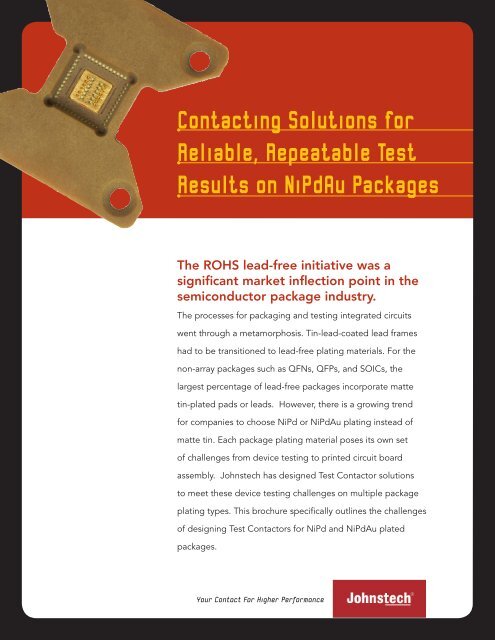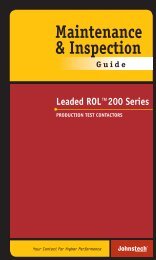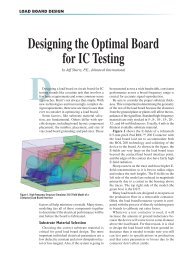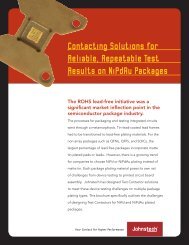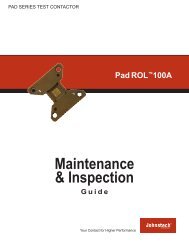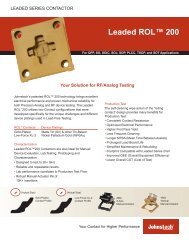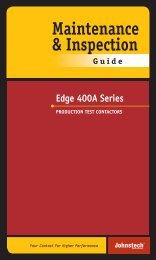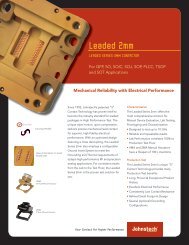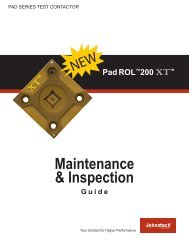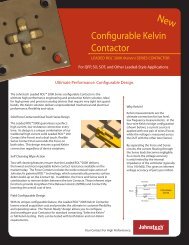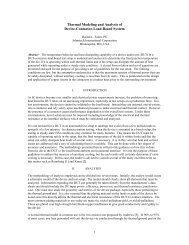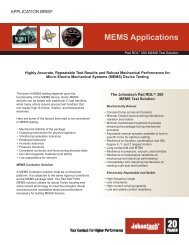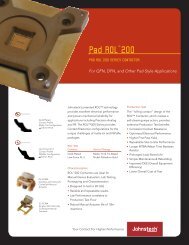Contacting Solutions for Reliable, Repeatable Test ... - Johnstech
Contacting Solutions for Reliable, Repeatable Test ... - Johnstech
Contacting Solutions for Reliable, Repeatable Test ... - Johnstech
Create successful ePaper yourself
Turn your PDF publications into a flip-book with our unique Google optimized e-Paper software.
<strong>Contacting</strong> <strong>Solutions</strong> <strong>for</strong><br />
<strong>Reliable</strong>, <strong>Repeatable</strong> <strong>Test</strong><br />
Results on NiPdAu Packages<br />
The ROHS lead-free initiative was a<br />
significant market inflection point in the<br />
semiconductor package industry.<br />
The processes <strong>for</strong> packaging and testing integrated circuits<br />
went through a metamorphosis. Tin-lead-coated lead frames<br />
had to be transitioned to lead-free plating materials. For the<br />
non-array packages such as QFNs, QFPs, and SOICs, the<br />
largest percentage of lead-free packages incorporate matte<br />
tin-plated pads or leads. However, there is a growing trend<br />
<strong>for</strong> companies to choose NiPd or NiPdAu plating instead of<br />
matte tin. Each package plating material poses its own set<br />
of challenges from device testing to printed circuit board<br />
assembly. <strong>Johnstech</strong> has designed <strong>Test</strong> Contactor solutions<br />
to meet these device testing challenges on multiple package<br />
plating types. This brochure specifically outlines the challenges<br />
of designing <strong>Test</strong> Contactors <strong>for</strong> NiPd and NiPdAu plated<br />
packages.<br />
Your Contact For Higher Per<strong>for</strong>mance
Advantages of<br />
NiPdAu<br />
There are several reasons <strong>for</strong> this transition to<br />
NiPdAu plated packages.<br />
1. Device users in high reliability applications<br />
such as medical, military, automotive and telecom<br />
had concerns about tin whisker growth in some<br />
matte tin packages under certain conditions.<br />
To limit the liability in high-reliability end-user<br />
applications, more testing and inspection is often<br />
required. This can lead to higher cost of test.<br />
While it is true that there are ROHS exemptions<br />
in some of these high reliability applications,<br />
many related applications still do not allow the<br />
use of tin-lead plated packages. There<strong>for</strong>e, the<br />
manufacturer must choose between matte tin and<br />
NiPdAu <strong>for</strong> their package plating.<br />
2. Matte tin-plated packages are prone to the<br />
buildup of tin oxides during package testing.<br />
When testing these parts, the contacting (socket)<br />
technology can build-up with these oxides,<br />
which increases the contact resistance (in an<br />
absolute sense) and increases the variation of<br />
the contact resistance (standard deviation). On<br />
the other hand, NiPdAu plated devices do not<br />
include tin, and there<strong>for</strong>e are not susceptible<br />
to the same tin oxide build-up as their matte<br />
tin package counterparts. <strong>Test</strong> Contactors such<br />
as those provided by <strong>Johnstech</strong> that include a<br />
self-cleaning wipe function significantly reduce<br />
the fluctuation in contact resistance, whether<br />
from oxide buildup in matte tin or other material<br />
residues associated with other platings.<br />
While many manufacturers initially opted <strong>for</strong><br />
matte tin packages due to the perceived lower<br />
acquisition costs, the bottom line is that many<br />
manufacturers are migrating to NiPdAu packages.<br />
In many cases, their overall costs are actually<br />
reduced due to the elimination of the additional<br />
tin whisker monitoring that was required with<br />
matte tin and the higher OEE that is gained by<br />
the reduction in cleaning frequency on the test<br />
floor.<br />
Challenges of NiPdAu<br />
While NiPdAu packages exhibit the benefits described earlier,<br />
there remain numerous challenges.<br />
1. The hard and often rough surface finish of NiPd and NiPdAu<br />
packages can cause excessive contact wear in <strong>Test</strong> Contactors and<br />
sockets..<br />
2. Package singulation is often accomplished by sawing the<br />
NiPdAu plated lead frames. This can leave a sharp burr on the<br />
edge of the package, leading to potential additional contact<br />
wear. Additionally, if the burr is dislodged during the handling or<br />
contacting process, the debris can cause more frequent cleaning<br />
cycles. Refer to the photo below.<br />
3. NiPdAu packages are not always clean and free of residues,<br />
adhesives, and debris. While oxides are not the issue like in matte<br />
tin packages, the presence of these contaminants can result in<br />
more frequent cleaning cycles. Having a self-cleaning contact<br />
wipe can extend the cleaning cycle interval, thus improving the<br />
MTBA.<br />
Variation in NiPd and NiPdAu Package Platings<br />
Some package vendors use NiPd plating while others add a thin<br />
layer of gold to produce a NiPdAu plating. The texture and<br />
consistency of NiPd or NiPdAu can differ significantly among<br />
manufacturers. For example, the photos shown here illustrate<br />
how the texture and grain structure can vary between two<br />
different package platings.<br />
NiPd<br />
NiPdAu
Contact Life Depends on Many Factors<br />
Since NiPd and NiPdAu platings are much harder and rougher than their matte tin counterparts, <strong>Test</strong> Contactors or sockets must<br />
be designed to withstand these challenges. Contact life depends not only on the package material plating properties, but it can<br />
vary even more significantly based on the handler-to-Contactor interface, handler velocity, whether auto alignment plates are used,<br />
alignment plate opening size and tolerances, and test temperature. <strong>Johnstech</strong> offers worldwide service and support to ensure the<br />
handler interface is optimized <strong>for</strong> highest yields, longest contact life, and extended MTBA.<br />
New <strong>Johnstech</strong> ROL Technology<br />
Low-Force XL Contacts<br />
<strong>Johnstech</strong> has developed the new Low-Force XL<br />
Series Contacts <strong>for</strong> the Pad ROL200 and ROL100A<br />
Contactors <strong>for</strong> NiPd and NiPdAu package applications.<br />
The new Low-Force XL (extended life) Contacts work in<br />
concert with new elastomers to provide an optimized<br />
contacting system <strong>for</strong> maximum contact life. The<br />
Contactors are designed to deliver the proper amount<br />
of <strong>for</strong>ce to both the device-under-test and the load<br />
board pads <strong>for</strong> longer contact life, exceptional continuity,<br />
longer MTBA, and longer load board pad life. The<br />
Low-Force XL Contacts provide a self-cleaning wipe <strong>for</strong><br />
excellent MTBA, even on NiPdAu surfaces that contain<br />
contaminants or debris. In addition, the contact motion is<br />
designed to avoid package burrs, resulting in less debris<br />
generation and longer contact life. The contact profiles<br />
and elastomers <strong>for</strong> the Pad ROL100A Series and<br />
Pad ROL200 Series configured <strong>for</strong> NiPd and NiPdAu<br />
applications are shown here.<br />
Pad ROL100A Series<br />
Pad ROL200 Series<br />
Customer Production Per<strong>for</strong>mance Improvements<br />
Customer production testing with the new Low-Force XL<br />
Contacts has provided solid per<strong>for</strong>mance results. They<br />
have experienced higher yields, improved continuity,<br />
longer load board pad life, and extended MTBA.<br />
Customers have seen significant improvements in contact<br />
life, often beyond 350,000 cycles, even with the most<br />
challenging NiPdAu and NiPd package platings.
<strong>Johnstech</strong> Services<br />
<strong>Johnstech</strong> offers a full line of technical services to assist you in achieving the<br />
highest level of per<strong>for</strong>mance. One of the services that is particularly powerful<br />
and effective <strong>for</strong> IC package testing is <strong>Johnstech</strong>’s use of HFSS and ADS<br />
software to model the electrical per<strong>for</strong>mance of the Contactor and the interface<br />
to the device and load board pads. This provides direction to select the best<br />
Contactor ground configuration <strong>for</strong> the application and to design the optimal<br />
load board trace layout, which are both vital to optimizing the overall system<br />
electrical per<strong>for</strong>mance.<br />
Contact <strong>Johnstech</strong><br />
To learn more about <strong>Johnstech</strong>’s<br />
patented solutions and services<br />
that maximize your precision analog<br />
testing per<strong>for</strong>mance, reduce your<br />
engineering risk, and provide<br />
repeatable production test results,<br />
contact your local <strong>Johnstech</strong> Sales<br />
Representative at www.johnstech.com.<br />
Electrical Specifications (NiPdAu Configuration) Pad ROL 200 Series Pad ROL 100A Series<br />
Inductance: Self: 0.50 nH 0.33 nH<br />
Mutual: 0.13 nH<br />
0.15 nH<br />
Capacitance: Ground: 0.30 pF 0.13 pF<br />
Mutual: 0.12 pF<br />
0.05 pF<br />
S 21<br />
Insertion Loss: -1dB @ 17.3 GHz -1dB @ 39.3 GHz<br />
S 11<br />
Return Loss: -20dB @ 5.2 GHz -20 dB @ 16.1 GHz<br />
S 41<br />
Crosstalk: -20dB @ 28.7 GHz -20 dB @ 40 GHz<br />
Current Carrying Capability: 4 A 4 A<br />
Compliance: 0.20 mm 0.175 – 0.20 mm<br />
Contactor configuration also available <strong>for</strong> Matte Tin packages. See website <strong>for</strong> specifications.<br />
Pad ROL200/ROL100A Series<br />
Per<strong>for</strong>mance Comparison<br />
The Low-Force XL Contacts are<br />
available <strong>for</strong> both the Pad ROL100A<br />
and Pad ROL200. The choice of<br />
Contactor usually depends on the<br />
electrical per<strong>for</strong>mance required <strong>for</strong> the<br />
device under test. Here is a summary<br />
of the per<strong>for</strong>mance differences<br />
between the two products.<br />
Applications<br />
The Pad ROL100A and ROL200 are used extensively <strong>for</strong> RF/wireless, precision<br />
analog, and high speed digital devices that require the highest electrical and<br />
mechanical per<strong>for</strong>mance <strong>for</strong> engineering and production applications. Offering the<br />
highest electrical per<strong>for</strong>mance, the ROL-series lowers your engineering risk and<br />
allows you to set tighter guard bands. With the consistent results it provides, ROLseries<br />
provides the robust mechanical per<strong>for</strong>mance and site-to-site repeatability in<br />
production applications to increase your yields and maximize your OEE.<br />
Summary<br />
The new <strong>Johnstech</strong> Low-Force XL Contacts <strong>for</strong> the Pad ROL100A and ROL200<br />
Contactors stand up to the challenges of NiPdAu and NiPd packages. Furthermore,<br />
the price of the XL Contacts has been significantly reduced compared to the<br />
previous Eco-1 Contacts. The extended contact life and lower spares costs will<br />
lower your overall cost of test. Refer to www.johnstech.com <strong>for</strong> technical product<br />
in<strong>for</strong>mation, or to contact your local <strong>Johnstech</strong> Representative.<br />
<strong>Johnstech</strong> International Corporation • 1210 New Brighton Boulevard • Minneapolis, MN 55413-1641 USA • Tel 612.378.2020 • Fax 612.378.2030 • www.johnstech.com • E-mail info@johnstech.com<br />
© Copyright 2009, <strong>Johnstech</strong> International Corporation. Specifications subject to change without notice. No part of this document may be reproduced in any <strong>for</strong>m or by any means, electronic<br />
or mechanical, including photocopying, recording or by any in<strong>for</strong>mation storage or retrieval system, without expressed written permission from <strong>Johnstech</strong>. <strong>Johnstech</strong> and <strong>Johnstech</strong> logo are


